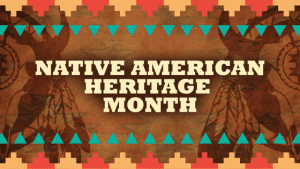National Native American Heritage Month is a time to recognize the histories, invaluable contributions and livelihood of American Indian and Alaska Native people in the United States. It is an opportunity to educate the general public about tribes, their cultures, traditions and languages. Use this time to highlight the unique challenges Native people have faced both historically and presently, as well as the ways in which tribal citizens have overcome these challenges.
One of the earliest proponents of a day honoring American Indians was Dr. Arthur Caswell Parker, a Cattaraugus Seneca born in 1881 and the director of the Rochester Museum in New York. Dr. Parker (Gawasco Waneh) was a noted anthropologist, historian and author whose great-uncle was secretary to General Ulysses S. Grant during the Civil War and the first American Indian to serve as Commissioner of Indian Affairs in the Department of the Interior.
 However, the origins of Native American Heritage Month officially began in 1986 when Congress passed a joint resolution which authorized President Ronald Reagan to proclaim the week of November 23-30, 1986 as “American Indian Week.” In 1990 President George H. W. Bush approved a joint resolution designating the month of November as “National American Indian Heritage Month.” Congress chose November to recognize American Indians as this month concluded the traditional harvest season and was generally a time of thanksgiving and celebration. Additionally, in 2009, President Barack Obama signed legislation that established the Friday immediately following Thanksgiving Day of each year as “Native American Heritage Day.”
However, the origins of Native American Heritage Month officially began in 1986 when Congress passed a joint resolution which authorized President Ronald Reagan to proclaim the week of November 23-30, 1986 as “American Indian Week.” In 1990 President George H. W. Bush approved a joint resolution designating the month of November as “National American Indian Heritage Month.” Congress chose November to recognize American Indians as this month concluded the traditional harvest season and was generally a time of thanksgiving and celebration. Additionally, in 2009, President Barack Obama signed legislation that established the Friday immediately following Thanksgiving Day of each year as “Native American Heritage Day.”
During Native American Heritage Month, find out what activities and celebrations are happening in local tribal communities. National Native American Heritage Month is celebrated with community gatherings, festivals and government and educational activities. Many schools celebrate the month by learning more about the history and contributions of American Indians and Alaska Natives in education, art, literature, government, sports, science and technology.
The National Museum of the American Indian in Washington, D.C., and New York City is celebrating the diversity and contributions of these Native cultures with free festivals and concerts, curators’ talks, and family activities all month long. For those unable to attend in person, the museum is webcasting many of these public programs live and archiving them online.
Leave a Reply